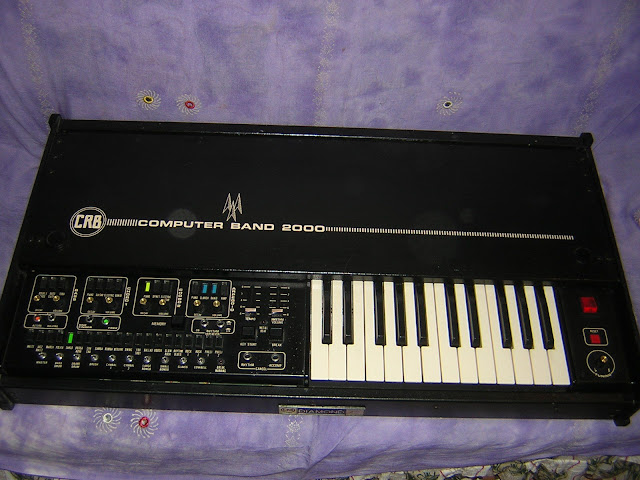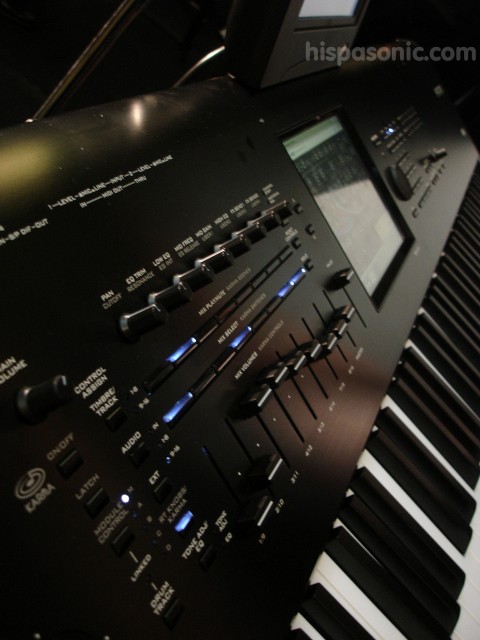Chris Muir wrote in to let me know pricing info and full details are now up at
EigenlabsThe Eigenharp Alpha to left is listed from £3,950 inc Vat
The Eigenharp Pico below comes in at £349 inc Vat
Details for the archives. See Eigenlabs for links and more.

Eigenharp Alpha
"A professional level instrument which allows the musician to play and improvise using a limitless range of sounds with virtuoso skill. The unique design of the keys makes this the most expressive electronic musical instrument ever made. The Alpha can play and record loops, change scale and key, transpose, alter tempo, program beats, create arrangements, switch and layer multiple sounds, all while the musician is performing live on stage.
Available in a variety of finishes, it has 120 highly sensitive keys, 12 percussion keys, 2 strip controllers, a breath pipe and numerous pedal inputs. This gives almost endless possibilities for flexible keyboard layouts, fast instrument switching and expressive musical control. The comprehensive software system provides a wealth of musical performance features, including playback of its own native instruments, many common software plugins, soundfonts or midi instruments.
The Alpha requires a Mac computer to run. Click here for full software specification.
What's in the box?
* Eigenharp Alpha
* Eigenharp Pro case by Hiscox.
* Product Activation card for website support and tutorial materials.
* Breath pipe.
* Two mouthpieces.
* Leather strap.
* Eigenharp Base Station.
* 6M Alpha to Base Station connecting cable.
* 3M Base Station to computer USB2 connecting cable.
* Eigenlabs laptop/Base Station and cables carry bag.
* Eigenlabs 8GB USB stick with latest install software (Macintosh) and getting started tutorials.
Hardware Specification
Keys
* 133 keys in all.
* 120 keys on the main keyboard.
* 12 percussion keys on the lower part of the instrument.
* Plus one mute key.
Key Properties:
* Sampled at 2000 samples/second, per key.
* 11 bit (2048 values) resolution.
* Sensitive to direct pressure and to lateral pressure in both directions.
Breath pipe:
* Sampled at 2000 samples/second.
* 12 bit (4098 value) resolution.
* Bidirectional, sensitive to blown and drawn breath.
* Removable, interchangeable mouthpiece for hygiene.
2 Strip Controllers:
* One on each side of the instrument, 480mm long.
* Sampled at 2000 samples/second per strip.
* 11 bit (2048 values) resolution.
Headphone output:
* 48kHz sampling rate, 24-bit DAC Sigma-Delta.
* Software programmable volume.
* Mute, soft ramp and zero cross detection for volume adjustment.
* SNR = 95dB.
* THD < 0.01% at 1kHz, 30-Ohm load at -3dbFS.
* Up to 750mW output on a 3.5mm mini jack.
Microphone input/preamp:
* Balanced input on an industry standard 4 pin LEMO locking connector.
* 24 bit at 96khz A/D converter.
* Low noise programmable gain from 10 to 55db in 1db steps.
* Software switchable 48V phantom power.
* 8.2V Electret polarisation power available, requires specific cable.
* Noise: EIN= (A-weighted) -120dBu with 150 Ohm source 20Hz to 20kHz, 50 dB gain. EIN Un-wtd= -125dBu with same conditions as A-weighted.
* 26dB software switchable input pad.
Recommended uni-directional (cardioid or supercardioid patterns) microphones:
* Sony ECM66BC, Audio Technica AT898C and AT831C, Sure WL184, DPA 4080 and DPA 4022. Note: Custom wiring for each microphone is required
Base Station:
* 2 inputs for continuous control expression pedals:
* Suitable for use with Boss FV50 and FV500 volume pedals.
* Suitable for use with Yamaha FC3 continuous control sprung sustain pedals.
* USB 2 interface to host computer.
* 2 inputs for foot switches.
Strap:
* Leather strap.
* Friction controlled multi axis instrument mounting.
Floor spike:
* 300mm retractable floor spike with removable rubber foot.
Instruments and soundfonts
You can load and play your own Soundfonts, Audio Unit Plugins and Midi instruments with the Eigenharp Alpha. In addition, the Alpha comes with its own native instruments (at present a software model of a Cello, Clarinet and a Synth engine). The Alpha also ships with a collection of loop libraries and several acclaimed instruments from our partners:
* 1500 AIFF format (timestretch and tempo change capable) varied Percussion and Drum loops.
* Sampletekk 'Black Grand Steinway D, sampled at 20+ levels in a 6 Gigabyte set that includes three recordings from dry to highly ambient.
* Sampletekk 'Tubed Rhodes', a multi sampled Rhodes Electric Piano.
* Sampletekk 'Wurlittzer' electric piano in a Gigabyte multi sample set.
System Requirements and Software
* Please see our Software page"

Eigenharp Pico
"The ultra-versatile Pico is simple to use and anyone can play it. Light and portable, it packs a powerhouse of features. Use it to play solo, play and record loops, change scale and key, transpose, alter tempo, program beats, create arrangements, switch and layer multiple sounds, all while playing live. It's ideal as a solo instrument or for playing in band.
With 18 playing keys and 4 mode keys, a strip controller and breath pipe, the smaller Pico has the majority of the playing features of the Eigenharp Alpha. It plays an unlimited range of sounds and is available in two finishes. The Eigenharp Pico, with its ease of playing and transformational approach to learning scales and music theory, represents a new and easier way to learn to play a musical instrument. The Pico gives you freedom to express your creativity through improvisation like no other electronic instrument in existence.
The Pico requires a Mac computer to run. Click here for full software specification.
What's in the box?
* Eigenharp Pico in robust cardboard carry case/box.
* Product Activation card for website support and tutorial materials.
* Breath pipe.
* Two mouthpieces.
* Neck strap.
* 3M Pico to computer USB2 connecting cable.
* Eigenlabs 8GB USB stick with latest install software (Macintosh) and getting started tutorials.
Hardware Specification
Keys
* 18 playing keys.
* Sampled at 2000 samples/second, per key.
* 11 bit (2048 values) resolution.
* Sensitive to direct pressure and to lateral pressure in both directions.
Breath pipe:
* Sampled at 2000 samples/second.
* 12 bit (4098 value) resolution.
* Sensitive to blown and drawn breath.
* Removable, interchangeable mouthpiece for easy hygiene.
Strip Controller:
* 180mm long.
* Sampled at 2000 samples/second.
* 10 bit (1024 values) resolution.
Other features:
* 4 Mode Switches.
* USB powered.
* Conformable, height adjustable thumb hooks.
* Neck strap.
Instruments and soundfonts
You can load and play your own Soundfonts, Audio Unit Plugins and Midi instruments with the Eigenharp Pico. In addition, the Pico comes with its own native instruments (at present a software model of a Cello, Clarinet and a Synth engine). The Pico also ships with a collection of loop libraries and several acclaimed instruments from our partners:
* 1500 AIFF format (timestretch and tempo change capable) varied Percussion and Drum loops.
* Sampletekk 'Black Grand Steinway D, sampled at 20+ levels in a 6 Gigabyte set that includes three recordings from dry to highly ambient.
* Sampletekk 'Tubed Rhodes', a multi sampled Rhodes Electric Piano.
* Sampletekk 'Wurlittzer' electric piano in a Gigabyte multi sample set.
System Requirements and Software
* Please see our Software page"
 "A rare collectable piece of equipment from the now defunkt POWERTRAN CYBERNETICS. These synths were originally sold as kits complete right down to the last nut and bolt. Designed by the legendary TIM ORR of EMS fame. A fully analogue synth designed on a single circuitboard. Gone now is the keyboard and original case, this one has been re boxed in a wood case. Now incorporates midi control that now allows connection to a computer sequencer or whatever midi device you like. Midi incorporates a push button learn facility for channel recognition. Midi control can be programmed via a PC and suitable cable allowing key span and adjustments. There are controls at the rear that allow precise tuning of octave width and pitch offset. Software links and some information will be provided on CDROM regarding these setup procedures. Now has a full compliment of moog style knobs however, the shafts that hold the knobs have been sanded to get these knobs to fit making the control turn slightly wobbly. All knobs work though with no noise, all have been cleaned. Incorporates an LFO rate indicator on the front panel. The original key switches used in the T2K become unreliable and can be a complete nightmare to set them all up correctly. With midi control this problem is eliminated. This unit plays exactly as a T2K should. A great sounding filter with a warm quality close to moog ladder designs. Incorporates band pass and low pass responce. Only genuine high quality components used when repaired and converted. Pictures show rear of the unit, midi in and thru sockets will be labelled before despatch."
"A rare collectable piece of equipment from the now defunkt POWERTRAN CYBERNETICS. These synths were originally sold as kits complete right down to the last nut and bolt. Designed by the legendary TIM ORR of EMS fame. A fully analogue synth designed on a single circuitboard. Gone now is the keyboard and original case, this one has been re boxed in a wood case. Now incorporates midi control that now allows connection to a computer sequencer or whatever midi device you like. Midi incorporates a push button learn facility for channel recognition. Midi control can be programmed via a PC and suitable cable allowing key span and adjustments. There are controls at the rear that allow precise tuning of octave width and pitch offset. Software links and some information will be provided on CDROM regarding these setup procedures. Now has a full compliment of moog style knobs however, the shafts that hold the knobs have been sanded to get these knobs to fit making the control turn slightly wobbly. All knobs work though with no noise, all have been cleaned. Incorporates an LFO rate indicator on the front panel. The original key switches used in the T2K become unreliable and can be a complete nightmare to set them all up correctly. With midi control this problem is eliminated. This unit plays exactly as a T2K should. A great sounding filter with a warm quality close to moog ladder designs. Incorporates band pass and low pass responce. Only genuine high quality components used when repaired and converted. Pictures show rear of the unit, midi in and thru sockets will be labelled before despatch."




























































